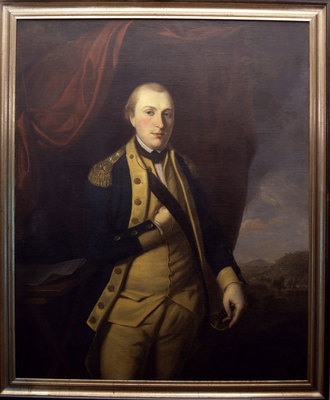
Description
In this, the first of two galleries in which Lafayette: An American Icon is mounted, you will find images of Lafayette as he was, when he first came to America in 1777 to fight in the American Revolution.
During these eventful few years, he was wounded in the Battle of Brandywine, spent the infamous winter of 1777 to 78 at Valley Forge with Washington and his troops, was given his own division of troops to command, and played a key role in the Battle of Yorktown, which ended the war with an American victory.
Among the masterpieces of portraiture that you will find in this gallery is one of the earliest paintings of Lafayette on the wall to your right as you enter the gallery.
Lafayette was only about sixteen years old when this portrait was painted: he had just heard of the Americans rebellion against the British.
Straight ahead of the entry to the gallery is a large portrait of Lafayette that was painted on commission in 1779 for George Washington himself, certainly an indication of just how impressed Washington was with the young Frenchman. For many years, this painting hung at Washingtons home Mount Vernon in Virginia.
To the left, you will see a white, plaster bust of Lafayette, which, like the painting just mentioned, had an illustrious first owner: It was made in the late 1780s in France, for Thomas Jefferson and was displayed by him at Monticello until his death in 1826. The sculptor who made the bust, Jean-Antoine Houdon, first took a cast of Lafayettes face from which to model his portrait. That casta life-maskis on view to here as well.
There are some later portraits of Lafayette here, too. The two large paintings at the far end of this room were painted in the 1820s in competition for a major commission that was given by the City of New York for a full-size portrait of Lafayette. And the large bronze equestrian figure of Lafayette was made just before the year 1900.
A monumental bronze cast of this sculpture, which is by the American sculptor Paul Bartlett, was given by the citizens of the United States to France for erection in the courtyard of the Louvre Museum in Paris. That gift was a way for Americans, including the many American school children who raised money for the project, to thank the French for their earlier gift of the Statue of Liberty that stands in New York Harbor.
There is much more to see and read about in this gallery. Take your time, and when you are ready, rejoin this recording in the next, smaller gallery.